New strategic threats to EU are coming from the most unexpected directions. I don’t mean COVID19. That has been a “black swan”. I mean what’s coming next.
At the time of this writing (mid-April 2020), EU institutions have been largely reduced to irrelevance. It’s not that their response to the COVID-19 crisis was weak or inadequate or insufficient. It’s that there has been no response at all.
In the face of a major crisis, the EU has demonstrated zero antifragility. Instead, it has shown a glaring weakness. And weakness invites trouble.
New strategic threats to EU can also be self-made. Consider this.
The EU and Turkey have been munching on the introduction of a visa free regime for holders of Turkish passports since 2013. This case study applies the Futures Wheel and the Force Field Analysis techniques to try and figure out what strategic changes it might bring. Will they include new strategic threats to EU?
Here are the main steps involved.
- Step 1. Define the trigger event.
- Step 2. Choose four first-tier consequences.
- Step 3. Complete the A1-A2-A3 path.
- Step 4. Complete the A1-A2-B3 path.
- Step 5. Complete the remaining paths of the A branch and all paths of B, C and D branches.
- Step 6. Identify the Most Probable Path.
Now, there is nothing very new about the Futures Wheel (FW) technique. Or method, as it is often called. It is probably second oldest to none. With a possible exception of the Multiple Perspective Utility Analysis. A search for FW will produce a heap of articles. Some 5,510,000, to be precise.
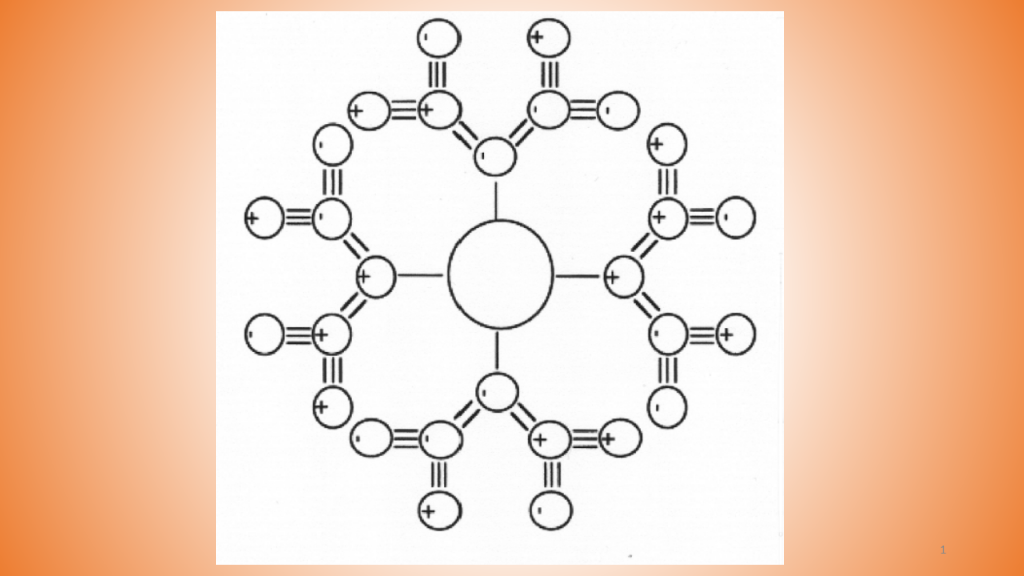
But try to search for “futures wheel method in foreign policy analysis” – and you get zero results. Try “futures wheel method in strategic analysis” – same story. The utility of the FW technique for strategic threat analysis appears to have been largely overlooked.
In the simplest of terms, FW belongs to the field of futures analysis. Here are some of the latter’s purposes.
- Provide a strategic context within which to understand emerging threats.
- Provide a foresight capacity to allow the development of targeted strategies, i.e. the warning of the need for new or different capabilities policies, responses, powers, etc.
- Narrow the range of uncertainty.
- Reduce the level of opacity that surrounds strategic issues.
The product of futures analysis should aim to be explicitly policy relevant. It belongs to estimative (predictive) intelligence meaning that it provides a range of possibilities with attendant assessment of their likelihood.
In this context, FW offers a framework for the structured brainstorming of consequences that a hypothetical trigger event could cause. FW also provides dynamic visualization of a cause-and-effect relationships between consequences as hypothetical futures unfold through the tiers.
Computer-unaided FW usually deals with three tiers of consequences that produce 16 possible non-exclusive futures.
Now, let’s get back to the issue at hand, which is the EU-Turkey Visa Liberalisation Dialogue (VLD).
Step 1. Define the trigger event.
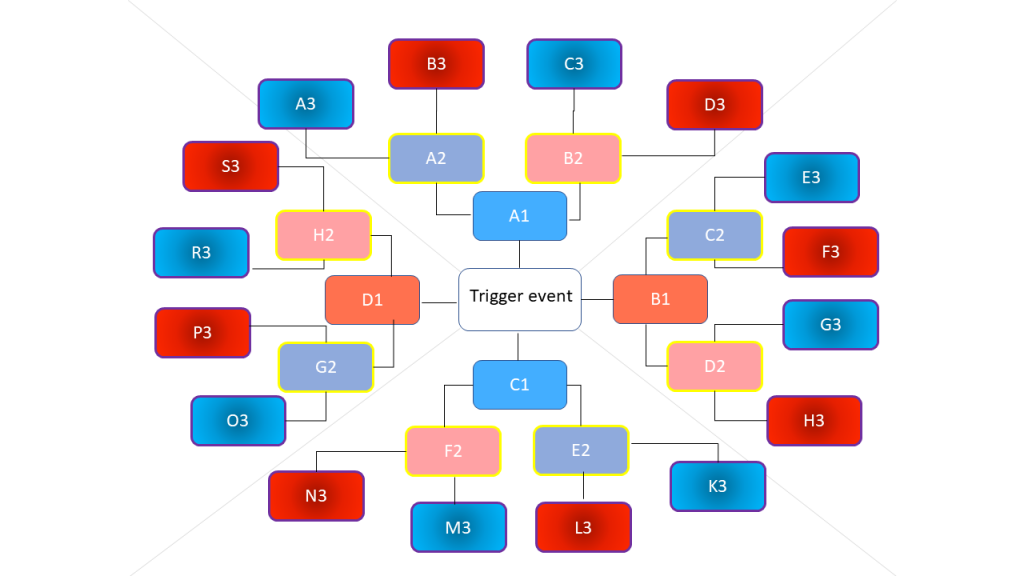
VLD has been going on (and off) between the EU and Turkey since 2013. In 2016, an imminent breakthrough seemed to be looming. But it was thwarted by the aftermath of the refugees steamrolling their way into the EU through (mostly) Turkey.
The VLD is based on the Roadmap towards a visa-free regime with Turkey. The latter sets out the requirements that Turkey needs to meet in order to enable the European Parliament and the Council to amend Regulation (EC) No 539/2001.
This amendment is what will allow Turkish citizens holding biometric passports that are in line with EU standards to travel for short stays to EU Member States without a visa. It will also allow EU MS citizens entering Turkey for short stays without a visa. A short stay is limited to 90 days within any 180-day period.
In early March 2020, Turkey has upped the stakes by announcing the abolishion of tourist visas for holders of the UK, Austrian, Belgian, Netherlands, Polish and Spanish passports. Nationals of Germany, France, Sweden, Italy, Ireland, and Finland were entitled to visa-free short stays for tourism and business even before that.
The Roadmap includes 72 benchmarks under five thematic groups. These are document security, migration management, public order and security, fundamental rights and readmission of irregular migrants.
Of the lot, the following seven benchmarks had yet to be fulfilled at the time of this writing (April 2020).
- Upgrading the existing biometric passports to include security features in line with the EU standards.
- Fully implementing the provisions of the EU-Turkey readmission agreement, including those related to the readmission of third country nationals.
- Adopting the measure to prevent corruption foreseen by the Roadmap, ensuring an effective follow-up to the recommendations issued by the Council of Europe’s Group of States against Corruption (GRECO).
- Aligning the legislation on personal data protection with EU standards, notably to ensure that the data protection authority can act in an independent manner and that the activities of law enforcement agencies fall within the scope of the law.
- Concluding an operational cooperation agreement with Europol.
- Offering effective judicial cooperation in criminal matters to all EU Member States.
- Revising the legislation and practices on terrorism in line with European standards, notably by better aligning the definition of terrorism in order to narrow the scope of the definition and by introducing a criterion of proportionality.
Our objective is to figure out the most probable consequences of an eventual successful completion of the VLD. Hate to rub the sore spot, but the nagging thought is – will it create new strategic threats to EU?
The trigger event will thus be, introduction of a visa-free regime between EU and Turkey.
Step 2. Choose four first-tier consequences.
First-tier consequences include two positive and two negative ones. This is a particularly important bit of the whole method. First-tier consequences will determine along which four main vectors our futures will evolve. Which means, there should be minimum overlap or duplication among them.
The broader the thematic or sectoral spread of first-tier consequences, the more diverse range of possible futures will pop out at the third tier.
FW is equally well-suited for conducting a more narrowed and deepened analytical delve. Its objective could be to study consequences of a trigger event confined to a particular security sector or a specific element of a strategic framework.
Either way, choosing first-tier consequences remains a serious task. And whenever faced with serious decision taking, it is wise to use divergent/convergent thinking to identify at least seven choices. And then put them through at least pair ranking, if not do the full monty and use weighted ranking.
When brainstorming, remember that first-tier consequences are immediate outcomes of the trigger event. And because of it they should reflect changes of operational rather than strategic nature.
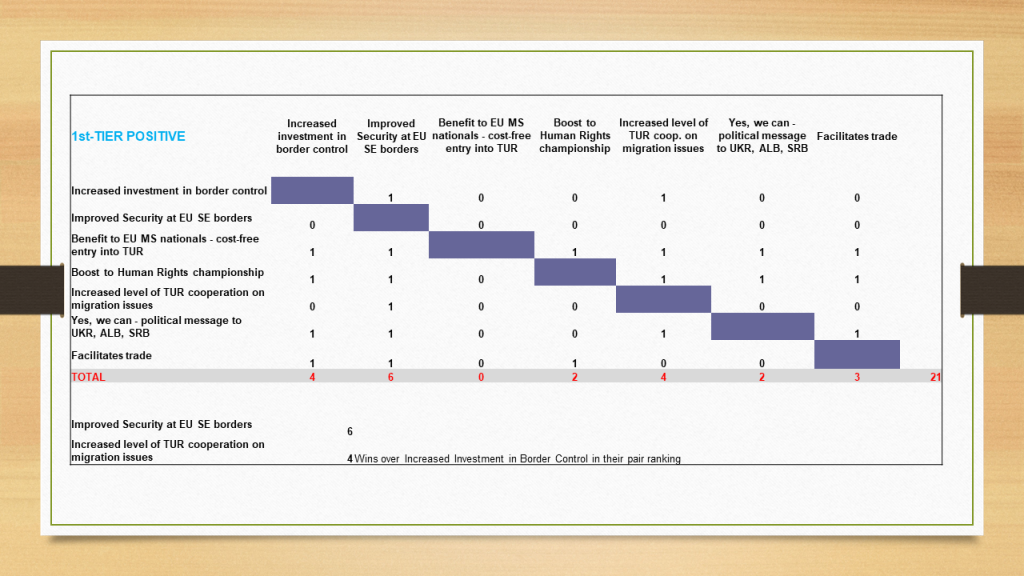
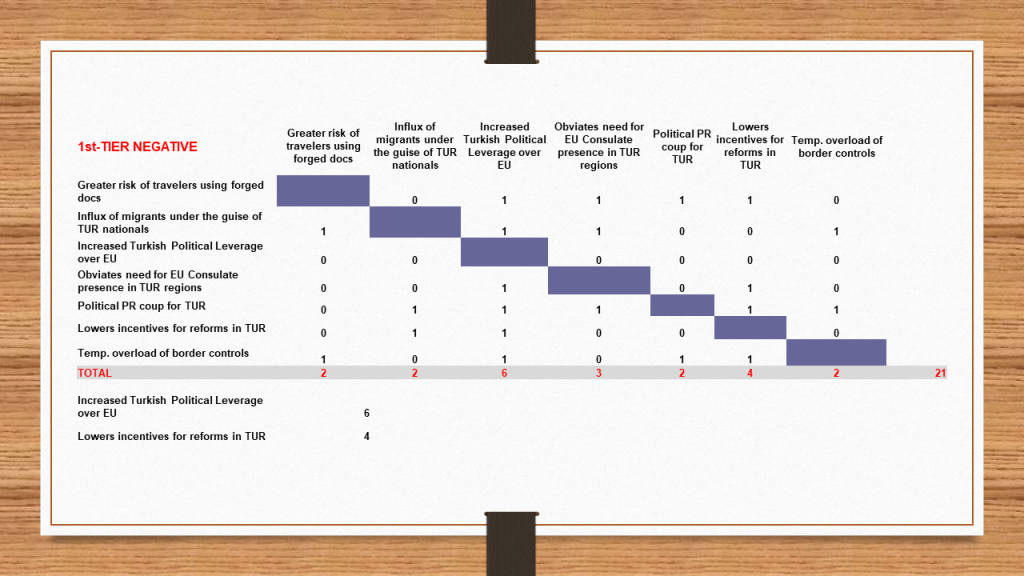
So, here are the first-tier consequences that have topped pair ranking.
- A1 – Improved security at EU South-East borders
- B1 – Lowers incentives for reforms in Turkey
- C1 – Increased level of Turkey’s cooperation on migration issues
- D1 – Increased Turkish political leverage over the EU
Step 3. Complete the A1-A2-A3 path.
To complete this step, you can start off on your left foot – or on your right one.
The “left-foot” method would result in replicating the above technique to choosing also second- and third-tier consequences. This approach may look mechanistic and a bit simplistic on top of that. But I don’t see anything fundamentally wrong with it.
However, since our intention is to combine FW with Force Field Analysis, we opt for the “right-foot” method.
Force Field Analysis (FFA) is a comparative tool that focuses on the relative weight of drivers that act for change (facilitators) or against it (inhibitors). The actionable purpose of FFA is to assess when inhibitors and facilitators are most vulnerable to external pressure. And consequently, where and when effort is likely to be best expended.
The golden rule of structured analysis is, ALWAYS start with the positive side of anything you are analyzing. Positive thinking is the best-known remedy against the negative bias.
As a species, humans are for some reason compulsively negative. And negative thinking is sticky. Once locked onto negative aspects, you will have a very hard time later trying to find positive ones.
Which means that to kick off, we run FFA on one positive first-tier consequence. And A1 – Improved Security at EU’s South-East border looks like a logical choice.
The FFA matrix may at first appear a bit counter-intuitive. Enabling forces are listed under “undesired outcome”. The logic here is that they push the status quo towards the “desired outcome”. Same applies to restraining forces that aim to push the status quo in the opposite direction and are consequently listed under “desired outcome”.
It is a good idea to FIRST list all the forces and only THEN assign them scores. This approach helps to suppress biases that can otherwise result in score inflation.
It is an equally good idea to set a cut-off value for force scores. Five or six are the usual choices. Then discard all forces that score below it. And replace them with new ones. What you’d want is focusing on really strong forces, both enabling and restraining. Otherwise your biased mind-set will take over your reasoning. And make you play at give-away.
I see hardly a need for thinking too long about each individual force score. Each of these taken separately is not really important. Their significance comes from aggregation. (I have demonstrated it in a case study that focused on analytic failure simulation.)
An FFA matrix for each consequence will include at least ten forces, five enabling and five restraining. A three-tier FW includes 28 consequences bringing the total number of scores to 280. That’s the minimum.
Using sets of fourteen forces instead of ten will increase the total number of force scores to 392. That can produce a more accurate forecast. But it will take more time and effort, too.
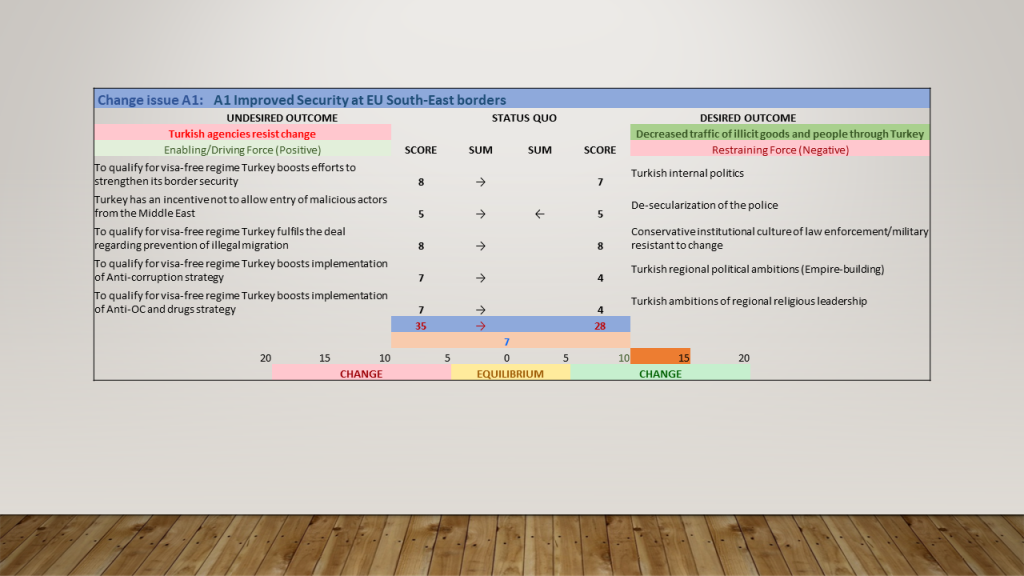
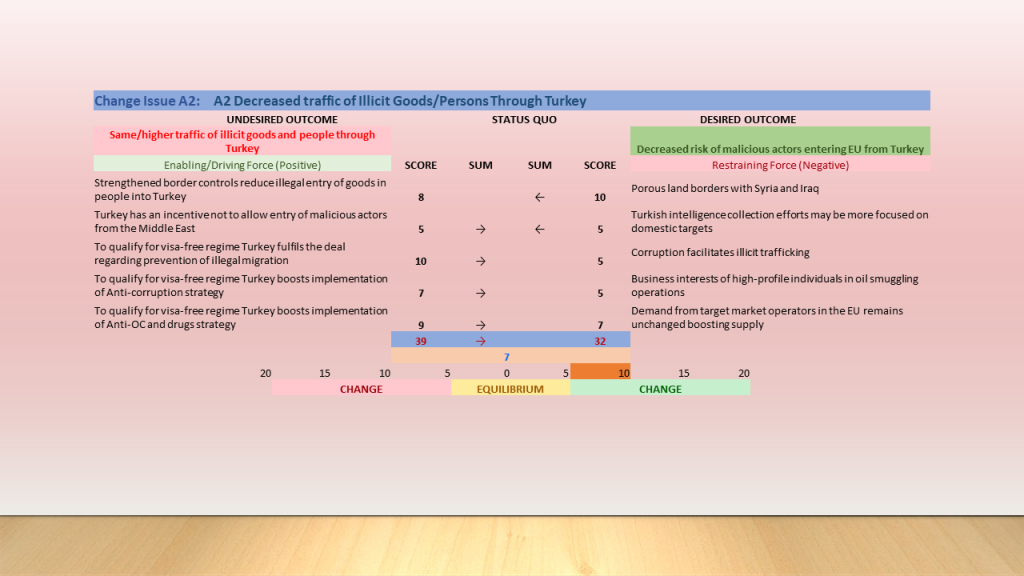
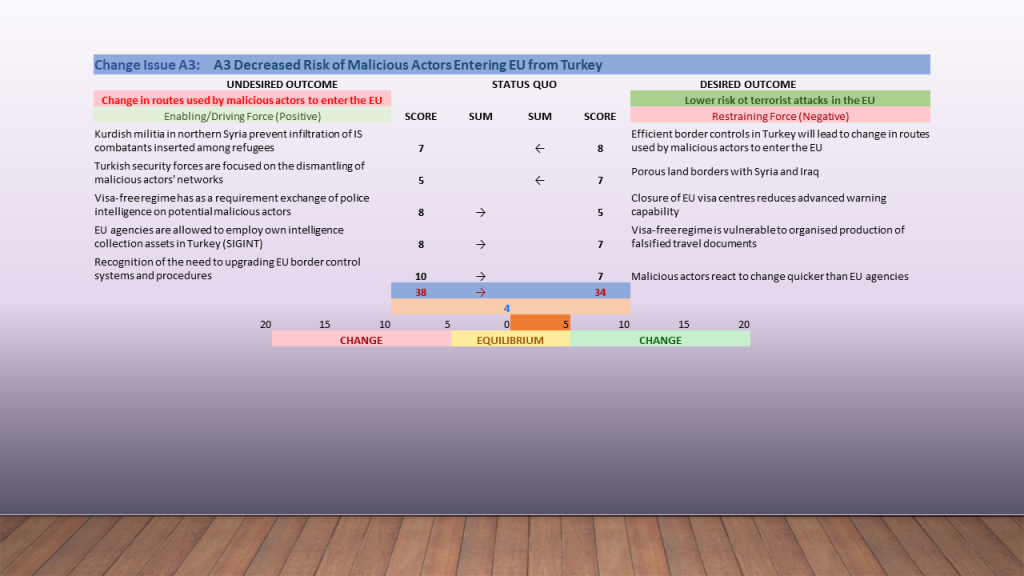
The winning outcome of each of the FFA matrices for first-tier consequences – whether “desired” or “undesired”– becomes a second-tier consequence, correspondingly a positive or a negative one. We discard the loosing outcome and not use it again later on.
- FFA A1 indicates a win for its desired outcome by a seven-point lead. “Decreased traffic of illicit goods/persons through Turkey” becomes A2 (positive) consequence.
- FFA A2 produces again a seven-point win for its desired outcome. “Decreased risk of malicious actors entering the EU from Turkey” becomes A3 (positive) consequence.
- FFA A3 generates a score of four in favor of its desired outcome.
A1-A2-A3 becomes a path leading from the trigger event to one of 16 possible third-tier futures. Its total strength is the sum of FFA scores: 7+7+4=18.
Step 4. Complete the A1-A2-B3 path.
Before moving on, it makes sense to complete the alternative path from A2. It will lead to B3.
B3 must be a negative consequence of A2. “Opening of new routes for illicit trafficking to the EU” comes out at the top of a quick pair ranking. By the way, desired/undesired outcomes in each FFA are also selected using pair ranking.
Looks like a lot of pair ranking… And before it, there is the brainstorming to decide on what we’ll be pair ranking. So, seems like there is tons of slow and tedious work involved, right?
It depends on where you are on the learning curve. None of my students had any experience with pair ranking prior to taking my course. To many, it did look a bit tedious and repetitive at first. That’s quite normal.
Structured reasoning is different from the comfy and erratic intuitive reasoning most of us are used to. Our mind resists the change. We need to bend it to our will. When faced with an iron resolve to do it the new way, it gives up resistance quickly.
After all, when using a simple template a pair ranking takes under a minute. And does not involve any particular brain strain. The preceding brainstorming should not require more than 15 minutes.
That’s why at the end of a course my students often admitted they actually came to like pair ranking. They found it to be effortless and amazingly accurate. And many started using it at every opportunity.
Using pair ranking in combination with divergent/convergent thinking is particularly effective when done in a group. And can lead to a sounder result. Group work is the only known remedy that can compensate or mitigate individual biases.
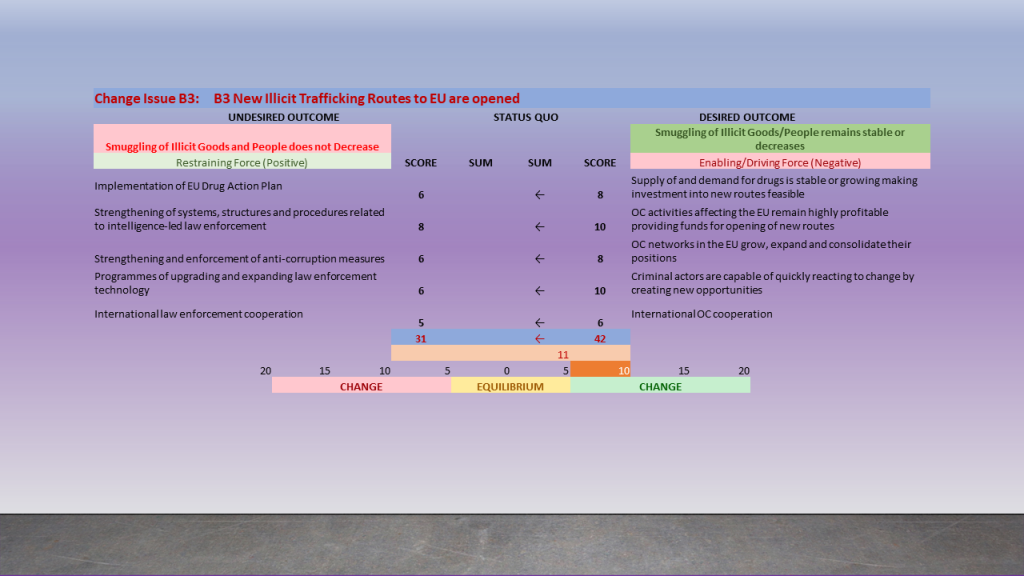
FFA B3 indicates that restraining forces prevail by 11 points. The path A1-A2-B3 thus obtains a score of 25.
Step 5. Complete the remaining paths of the A branch and all paths of B, C and D branches.
Completing the remaining paths using the same process produces this FW chart.
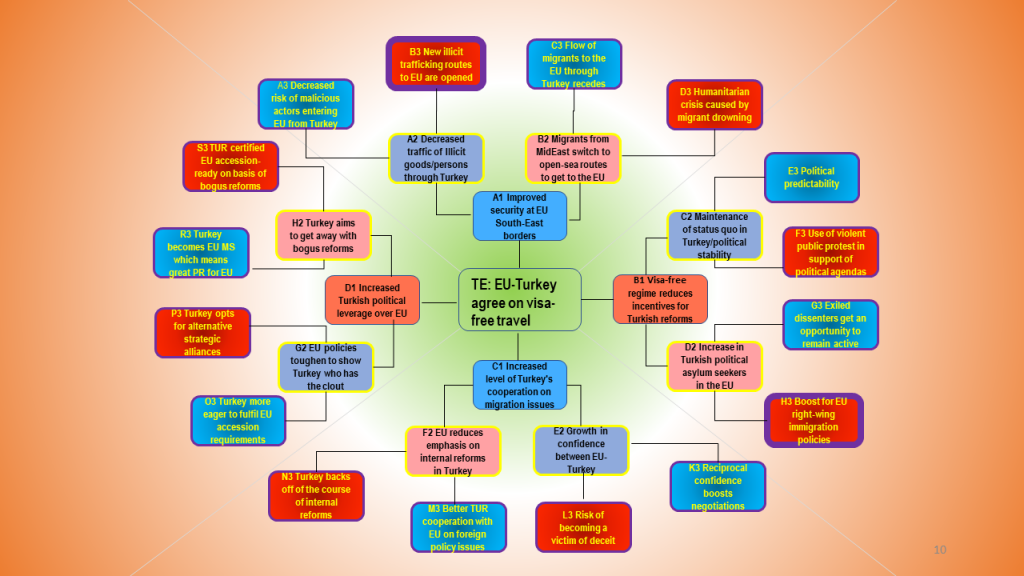
Step 6. Identify the Most Probable Path.
FFA yields the following path scores.
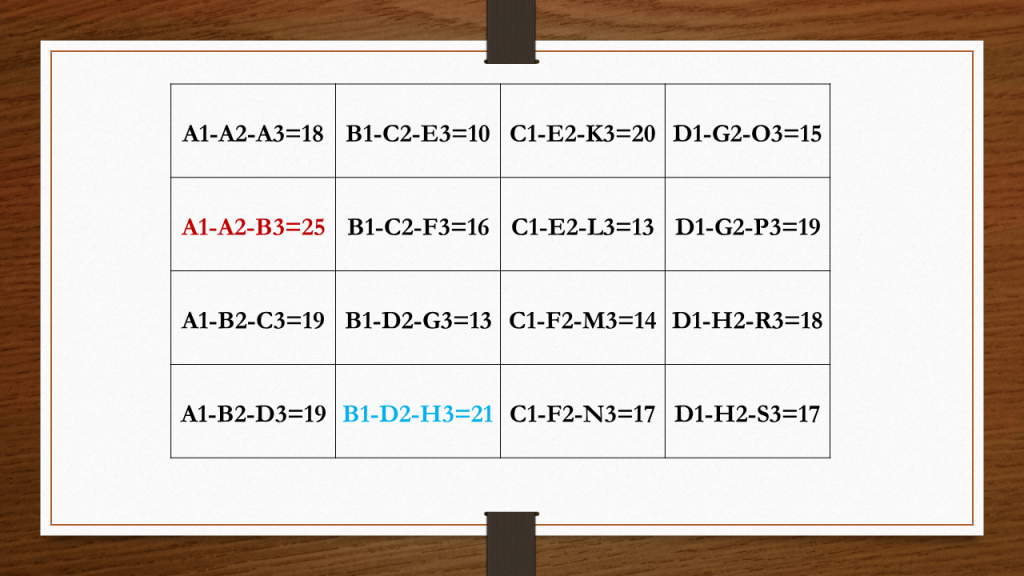
- A1-A2-B3 comes out as the Most Probable Path with a score of 25.
- B1-D2-H3 is a runner-up with a score of 21.
Note that both B3 and H3 are negative consequences.
Meaning, potentially they are new strategic threats to EU.
This is precisely the added value FFA brings to the FW method. FW produces a range of 16 possible futures. FFA helps to rank these according to the odds of their unfolding. And indicate the most probable one of the lot.
Choice of individual consequences can be easily challenged by critics. But this is broadly considered foul play. What critics CAN challenge is the PRODUCT of your analysis. Which is the Most Probable Path.
FW produces a set of 16 possible futures. However, it does not mean that the actual future WILL be among those.
Future is radically indeterminate. There is an infinite number of futures. It is impossible to predict, which one will unfold with certainty. We can only make such a prediction with a degree of probability.
Our analytic product is the Most Probable Path. It offers a judgment regarding which one from the sample of futures we have identified and considered is most likely to happen.
Or to be more precise, which future is most likely to happen FIRST. Some of our 16 futures can unfold in parallel or sequentially.
The Most Probable Path is A1-A2-B3.
- A1 Improved Security at EU South-East borders.
- A2 Decreased traffic of Illicit Goods/Persons Through Turkey.
- B3 New Illicit Trafficking Routes to EU are opened.
B3 is thus a future that has a higher probability of happening first.
It may appear like an obvious, common-sense conclusion.
Was it then worth spending time and effort on conducting FW+FFA to arrive at it?
Absolutely.
Compare:
- An inference based on possibly flawed intuition and subject to confirmation bias.
- An inference based on the systematic refuting/disproving of alternatives using several bias-compensating structured techniques.
No question, there is a vast difference in the reliability of these predictions. And in the accuracy of their probability estimate.
Now, a few conclusions.
- Analysis that applies FW+FFA techniques uses at least 280 individual data points. That’s a lot. They produce a stable and defensible result.
- When generating consequences, you can (and even should) let your fantasies soar free. Leave it to FW to judge whether they are just fantasies. If so, no harm done as they will be weeded out. If, on the other hand, they turn out to be feasible futures, the better so.
- As a matter of fact, strategic scenarios that go out on a limb rarely score high enough to become the Most Probable Path.
- Being the product of 280 values, an MPP tends to be fairly stable. Say, what if tomorrow you decide to review all your scores and may be change some? It’s a good bet that off-the-cuff changes won’t affect the MPP.
- MPP is likely to change only if you get some new insight. Or a new piece of key evidence. Or change a key assumption.
- MPP does not convey certainty. It only suggests a comparative probability.
- Numbers are good and helpful. But REMEMBER: numbers mean to INFORM us, NOT DOMINATE us.
Is this all there is to the FW+FFA technique?
No, there is more. Quite a bit more.
There are nuances and caveats that got left out of the plot. You’ve probably observed or sensed the gaps in the analytic process. I’m sure you’ve stumbled across quite a few “why so?” and “how does that work?” questions.

